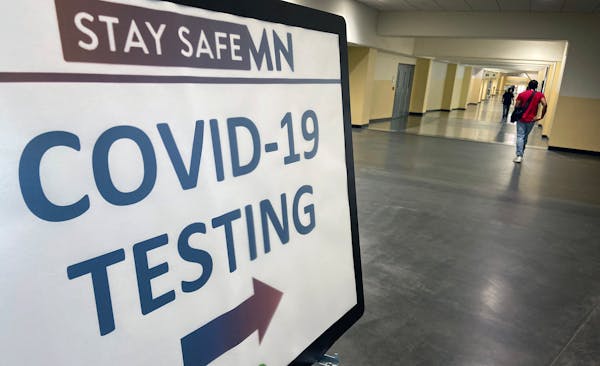More than three-quarters of Americans diagnosed with long COVID were not sick enough to be hospitalized for their initial infection, a new analysis of tens of thousands of private insurance claims reported Wednesday.
The researchers analyzed data from the first few months after doctors began using a special diagnostic code for the condition that was created last year. The results paint a sobering picture of long COVID's serious and ongoing impact on people's health and the U.S. health care system.
Long COVID, a complex constellation of lingering or new post-infection symptoms that can last for months or longer, has become one of the most daunting legacies of the pandemic. Estimates of how many people may ultimately be affected have ranged from 10-30% of infected adults; a recent report from the U.S. Government Accountability Office said that between 7.7 million and 23 million people in the United States could have developed long COVID. But much remains unclear about the prevalence, causes, treatment and consequences of the condition.
The new study adds to a growing body of evidence that, while patients who have been hospitalized are at greater risk for long COVID, people with mild or moderate initial coronavirus infections — who make up the vast majority of coronavirus patients — can still experience debilitating post-COVID symptoms including breathing problems, extreme fatigue, and cognitive and memory issues.
"It's generating a pandemic of people who were not hospitalized but who ended up with this increased disability," said Dr. Paddy Ssentongo, an assistant professor of infectious disease epidemiology at Penn State, who was not involved in the new study.
The analysis, based on what the report calls the largest database of private health insurance claims in the United States, found 78,252 patients who were diagnosed with the new code from the International Classification of Diseases — diagnostic code U09.9 for "Post COVID-19 condition, unspecified" — between Oct. 1, 2021, and Jan. 31, 2022.
Dr. Claire Steves, a clinical academic and physician at King's College London, who was not involved in the new research, said the overall number of people who received the diagnosis was "huge," given that the study covered only the first four months after the diagnostic code was introduced and did not include people covered by government health programs like Medicaid or Medicare (though it did include people in private Medicare Advantage plans). "That's probably a drop in the ocean compared to what the real number is," Steves said.
The study, conducted by FAIR Health, a nonprofit organization that focuses on health care costs and insurance issues, found that 76% of the long COVID patients did not require hospitalization for their initial coronavirus infection.
Another striking finding was that while two-thirds of the patients had preexisting health conditions in their medical records, nearly one-third did not — a much larger percentage than Ssentongo said he would have expected. "These are people who have been healthy, and they're like, 'Guys, something is not right with me,'" he said.
The researchers plan to continue to track the patients to see how long their symptoms last, but Robin Gelburd, president of FAIR Health, said that the organization decided to publish data from the first four months now, "given the urgency" of the issue.
She said researchers were working to try to answer some of the questions that are not addressed in the report, including providing detail on some patients' previous health conditions to try to identify whether certain medical problems put people at higher risk of long COVID.
The organization also plans to analyze how many patients in the study were vaccinated and when, Gelburd said. More than three-quarters of the patients in the study were infected in 2021, most of those in the last half of the year. On average, patients were still experiencing long COVID symptoms that qualified for the diagnosis 4 1/2 months after their infection.
The findings suggest a potentially staggering impact of long COVID on people in the prime of their lives, and on society at large. Nearly 35% of the patients were ages 36-50, while nearly one-third were ages 51-64, and 17% were ages 23-35. Children were also diagnosed with post-COVID conditions: Nearly 4% of the patients were 12 or younger, while nearly 7% were ages 13-22.
Six percent of the patients were 65 and older, a proportion that most likely reflects the fact that patients covered by the regular Medicare program were not included in the study. They were much more likely than the younger groups with long COVID to have had preexisting chronic medical conditions.
The insurance data analyzed did not include information about the race or ethnicity of patients, researchers said.
The analysis, which Gelburd said was evaluated by an independent academic reviewer but not formally peer-reviewed, also calculated a risk score for the patients, a way of estimating how likely people are to use health care resources. Comparing all the insurance claims the patients had up until 90 days before they contracted COVID with their claims 30 days or more after they were infected, the study found that average risk scores went up for patients in every age group.
Gelburd and other experts said the scores suggested that the repercussions of long COVID are not simply confined to increased medical spending. They signal "how many people are leaving their jobs, how many are being given disability status, how much absenteeism is there in school," Gelburd said. "It's like a pebble thrown into the lake, and these ripples circling that pebble are concentric circles of impact."
Because the study captured only a privately insured population, Ssentongo said, it almost certainly understates the scope and burden of long COVID, especially since low-income communities have been disproportionately affected by the virus and often have less access to health care. "I think it may even be worse if we added in the Medicaid population and all these other people that would have been missed" in the study's data, he said.
Sixty percent of the patients with the post-COVID diagnosis were female, the study reported, compared with 54% of COVID patients overall in the FAIR Health database. In the oldest and youngest age groups, however, there were roughly as many males as females.
"I think there is a female preponderance in terms of this condition," Steves said, adding that the reasons could include differences in biological factors that make women more prone to autoimmune conditions.
The insurance claims showed that nearly one-quarter of the post-COVID patients had respiratory symptoms; nearly one-fifth had coughs; and 17% had been diagnosed with malaise and fatigue, a far-reaching category that could include issues like brain fog and exhaustion that get worse after physical or mental activity. Other common issues included abnormal heartbeats and sleep disorders.
Generalized anxiety disorder was more common for 23- to 35-year-olds than for other age groups, the study reported, while hypertension was more common in the oldest patients.
Last year, FAIR Health published a study tracking insurance records of nearly 2 million people who had contracted COVID-19, which found that one month or more after their infection, almost one-quarter of them — 23% — sought medical treatment for new conditions.
The new study tried to determine how common certain symptoms were before the patients got infected compared with the period when those same patients were diagnosed with post-COVID conditions. It found that some typically uncommon health issues were much more likely to emerge during long COVID. For example, muscle problems occurred 11 times more often in the patients with long COVID; pulmonary embolisms occurred 2.6 times more often; and certain types of brain-related disorders occurred two times more often, the study said.
Like previous studies, the report found that if patients did need hospitalization for their initial infection, they were at higher risk of long-term symptoms than patients who were not hospitalized. The report came to that conclusion because about 24% of the patients diagnosed with a post-COVID condition had been hospitalized — more of them male than female — while only about 8% of all coronavirus patients needed hospitalization.
Still, because the vast majority of people do not need to be hospitalized for their infection, medical experts said this and other studies indicate that many people with mild or moderate initial illness will end up with lingering symptoms or new post-COVID health problems.
Gelburd and medical experts said that as doctors become more acquainted with the U09.9 code, they might use it in different circumstances than they did in the first four months. One recent analysis found that doctors' use of the code has been inconsistent so far.
Given the likely scale of long COVID, Ssentongo said he expects that in the future, doctors will ask patients if they have ever been diagnosed with post-COVID conditions, just as doctors ask about other previous medical problems so they can treat patients appropriately.
"Post-COVID syndrome is going to become perhaps one of the most common preexisting comorbidities going forward," he said.
This article originally appeared in The New York Times.

